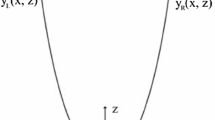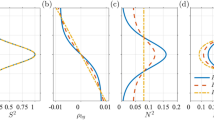Summary
In this study, the response of a dynamically unstable shear flow with a critical level to periodic forcing is presented. An energy argument is proposed to explain the upshear tilt of updrafts associated with disturbances in two-dimensional stably stratified flows. In a dynamically unstable flow, the energy equation requires an upshear tilt of the perturbation streamfunction and vertical velocity whereU z is positive. A stability model is constructed using an iteration method. An upshear tilt of the vertical velocity and the streamfunction fields is evident in a dynamically unstable flow, which is required by energy conversion from the basic shear to the growing perturbation wave energy according to the energy argument. The momentum flux profile indicates that the basic flow is decreased (increased) above (below) the critical level. Thus, the shear instability tends to smooth the shear layer. Following the energy argument, a downshear tilt of the updraft is produced in an unstably stratified flow since the perturbation wave energy is negative. The wave energy budget indicates that the disturbance is caused by a thermal instability modified by a shear flow since the potential energy grows faster than the kinetic energy.
Similar content being viewed by others
References
Asai, T., 1970: Stability of a plane parallel flow with variable vertical shear and unstable stratification.J. Meteor. Soc. Japan,48, 129–139.
Booker, J. R., Bretherton, F. P., 1967: The critical layer for internal gravity waves in a shear flow.J. Fluid Mech.,27, 513–539.
Bretherton, F. P., 1966: The propagation of groups of internal gravity waves in a shear flow.Quart. J. Roy. Meteor. Soc.,92, 466–480.
Chimonas, G., Einaudi, F., Lalas, D. P., 1980: A wave theory for the onset and initial growth of condensation in the atmosphere.J. Atmos. Sci.,37, 827–845.
Cram, J. M., Pielke, R. A., Cotton, W. R., 1992: Numerical simulation and analysis of a prefrontal squall line. Part II: Propagation of the squall line as an internal gravity wave.J. Atmos. Sci.,49, 209–225.
Drazin, P. G., Reid, W. H., 1981:Hydrodynamic Stability. Cambridge: Cambridge University Press, 527 pp.
Eliassen, A., Palm, E., 1960: On the transfer of energy in stationary mountain waves.Geofys. Publ.,22, 1–23.
Eliassen, A., Hoiland, E., Riis, E., 1953: Two-dimensional perturbations of a flow with constant shear of a stratified fluid. Inst. Weather Climate Res., Oslo, Publ. No. 1.
Koch, S. E., Dorian, P. B., 1988: A mesoscale gravity wave event observed during CCOPE. Part III: Wave environment and probable source mechanism.Mon. Wea. Rev.,116, 2570–2592.
Lin, Y.-L., 1987: Two-dimensional response of a stably stratified shear flow to diabatic heating.J. Atmos. Sci.,44, 1375–1393.
Lin, Y.-L., Li, S., 1988: Three-dimensional response of a shear flow to elevated heating.J. Atmos. Sci.,45, 2987–3002.
Lindzen, R. S., 1974: Stability of a Helmholtz velocity profile in a continuously stratified, infinite Boussinesq fluid —Applications to a clear air turbulence.J. Atmos. Sci.,31, 1507–1514.
Lindzen, R. S., Tung, K.-K., 1976: Banded convective activity and ducted gravity waves.Mon. Wea. Rev.,104, 1602–1617.
Maslowe, S. A., 1972: The generation of clear-air turbulence by nonlinear waves.Stud. Appl. Math. 51, 1–16.
Moncrieff, M. W., 1978: The dynamical structure of two-dimensional steady convection in constant vertical shear.Quart. J. Roy. Meteor. Soc.,104, 543–567.
Pedlosky, J., 1982:Geophysical Fluid Dynamics, 2nd edn. Berlin, Heidelberg: Springer, 624 pp.
Ramage, C. S., 1971:Monsoon Meteorology. New York: Academic Press, 296 pp.
Raymond, D. J., 1984: A wave-CISK model of squall lines.J. Atmos. Sci.,41, 1946–1958.
Seitter, K. L., Kuo, H. L., 1983: The dynamical structure of squall-line type thunderstorms.J. Atmos. Sci.,30, 835–856.
Stone, P. H., 1970: On non-geostrophic baroclinic instability: Part II.J. Atmos. Sci.,27, 721–726.
Tanaka, H., 1975: Quasi-linear and non-linear interactions of finite amplitude perturbations in a stably stratified fluid with hyperbolic tangent shear.J. Meteor. Soc. Japan,53, 1–31.
Thorpe, A. J., Miller, M. J., Moncrieff, M. W., 1982: Two-dimensional convection in non-constant shear: A model of mind-latitude squall lines.Quart. J. Roy. Meteor. Soc.,108, 739–762.
Author information
Authors and Affiliations
Additional information
With 4 Figures
Rights and permissions
About this article
Cite this article
Lin, Y.L., Chun, H.Y. Structures of dynamically unstable shear flows and their implications for shallow internal gravity waves. Meteorl. Atmos. Phys. 52, 59–68 (1993). https://doi.org/10.1007/BF01025753
Received:
Revised:
Issue Date:
DOI: https://doi.org/10.1007/BF01025753




